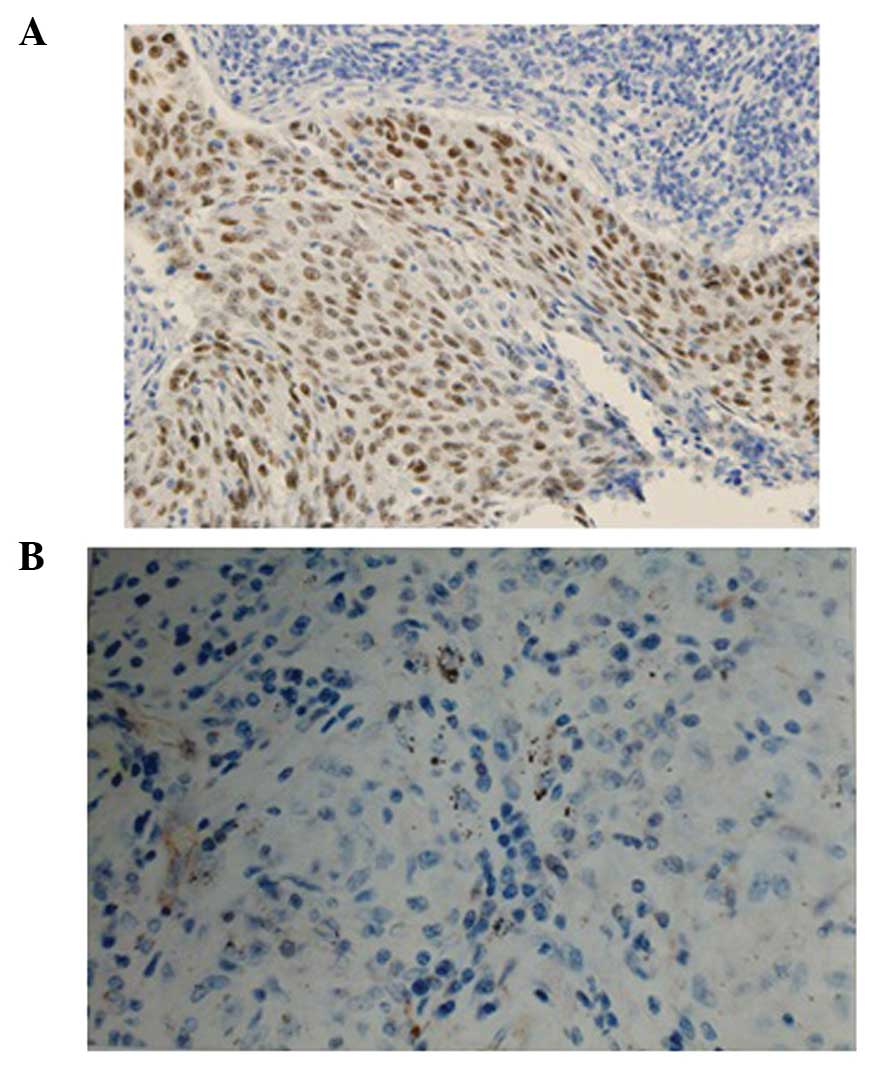|
1
|
Al-Badawi IA, Al-Suwaine A, Al-Aker M,
Asaad L, Alaidan A, Tulbah A, Fe Bohol M and Munkarah AR: Detection
and genotyping of human papilloma virus in cervical cancer
specimens from Saudi patients. Int J Gynecol Cancer. 21:907–910.
2011. View Article : Google Scholar : PubMed/NCBI
|
|
2
|
Al-Shabanah OA, Hafez MM, Hassan ZK,
Sayed-Ahmed MM, Abozeed WN, Al-Rejaie SS and Alsheikh AA: Human
papillomavirus genotyping and integration in ovarian cancer Saudi
patients. Virol J. 10:343–352. 2013. View Article : Google Scholar : PubMed/NCBI
|
|
3
|
Yang X and Lu L: Expression of HPV-16 E6
protein and p53 inactivation increases the uterine cervical cancer
invasion. Drug Res (Stuttg). 65:70–73. 2015.PubMed/NCBI
|
|
4
|
Aumayr K, Susani M, Horvat R, Wrba F,
Mazal P, Klatte T, Koller A, Neudert B and Haitel A: P16INK4A
immunohistochemistry for detection of human papilloma
virus-associated penile squamous cell carcinoma is superior to
in-situ hybridization. Int J Immunopathol Pharmacol. 26:611–620.
2013.PubMed/NCBI
|
|
5
|
Sarchianaki E, Derdas SP, Ntaoukakis M, et
al: Detection and genotype analysis of human papillomavirus in
non-small cell lung cancer patients. Tumour Biol. 35:3203–3209.
2014. View Article : Google Scholar : PubMed/NCBI
|
|
6
|
Yu Y, Yang A, Hu S and Yan H: Correlation
of HPV-16/18 infection of human papillomavirus with lung squamous
cell carcinomas in Western China. Oncol Rep. 21:1627–1632.
2009.PubMed/NCBI
|
|
7
|
Jafari H, Gharemohammadlou R, Fakhrjou A,
et al: Genotyping of human papillomavirus and TP53 mutations at
exons 5 to 7 in lung cancer patients from Iran. Bioimpacts.
3:135–140. 2013.PubMed/NCBI
|
|
8
|
Ragin C, Obikoya-Malomo M, Kim S, et al:
HPV-associated lung cancers: An international pooled analysis.
Carcinogenesis. 35:1267–1275. 2014. View Article : Google Scholar : PubMed/NCBI
|
|
9
|
Hasegawa Y, Ando M, Kubo A, Isa S,
Yamamoto S, Tsujino K, Kurata T, Ou SH, Takada M and Kawaguchi T:
Human papilloma virus in non-small cell lung cancer in never
smokers: A systematic review of the literature. Lung Cancer.
83:8–13. 2014. View Article : Google Scholar : PubMed/NCBI
|
|
10
|
Ohta M, Inoue H, Cotticelli MG, et al: The
FHIT gene, spanning the chromosome 3p14.2 fragile site and renal
carcinoma-associated t(3;8) breakpoint, is abnormal in digestive
tract cancers. Cell. 84:587–597. 1996. View Article : Google Scholar : PubMed/NCBI
|
|
11
|
Wistuba II, Montellano FD, Milchgrub S, et
al: Deletions of chromosome 3p are frequent and early events in the
pathogenesis of uterine cervical carcinoma. Cancer Res.
57:3154–3158. 1997.PubMed/NCBI
|
|
12
|
Wilke CM, Hall BK, Hoge A, Paradee W,
Smith DI and Glover TW: FRA3B extends over a broad region and
contains a spontaneous HPV16 integration site: Direct evidence for
the coincidence of viral integration sites and fragile sites. Hum
Mol Genet. 5:187–195. 1996. View Article : Google Scholar : PubMed/NCBI
|
|
13
|
Wang J, Cheng YW, Wu DW, Chen JT, Chen CY,
Chou MC and Lee H: Frequent FHIT gene loss of heterozygosity in
human papillomavirus-infected non-smoking female lung cancer in
Taiwan. Cancer Lett. 235:18–25. 2006. View Article : Google Scholar : PubMed/NCBI
|
|
14
|
Yu Y, Yang A, Hu S, Zhang J and Yan H:
Significance of human papillomavirus 16/18 infection in association
with p53 mutation in lung carcinomas. Clin Respir J. 7:27–33. 2013.
View Article : Google Scholar : PubMed/NCBI
|
|
15
|
Münger K, Baldwin A, Edwards KM, Hayakawa
H, Nguyen CL, Owens M, Grace M and Huh K: Mechanisms of human
papillomavirus-induced oncogenesis. J Virol. 78:11451–11460. 2004.
View Article : Google Scholar : PubMed/NCBI
|
|
16
|
Greer CE, Wheeler CM and Manos MM: PCR
amplification from paraffin-embedded tissues: sample preparation
and the effects of fixationPCR Primer: a laboratory manual. Carl WD
and Gabriela SD: Cold Spring Harbor Laboratory Press; New York: pp.
99–112. 1995
|
|
17
|
Wang JL, Fang CL, Wang M, Yu MC, Bai KJ,
Lu PC and Liu HE: Human papillomavirus infections as a marker to
predict overall survival in lung adenocarcinoma. Int J Cancer.
134:65–71. 2014. View Article : Google Scholar : PubMed/NCBI
|
|
18
|
Badillo-Almaraz I, Zapata-Benavides P,
Saavedra-Alonso S, Zamora-Avila D, Reséndez-Pérez D, Tamez-Guerra
R, Herrera-Esparza R and Rodríguez-Padilla C: Human papillomavirus
16/18 infections in lung cancer patients in Mexico. Intervirology.
56:310–315. 2013. View Article : Google Scholar : PubMed/NCBI
|
|
19
|
Iwakawa R, Kohno T, Enari M, Kiyono T and
Yokota J: Prevalence of human papillomavirus 16/18/33 infection and
p53 mutation in lung adenocarcinoma. Cancer Sci. 101:1891–1896.
2010. View Article : Google Scholar : PubMed/NCBI
|
|
20
|
Bahnassy AA, Zekri AR, Madbouly MS,
El-Naggar M, El-Khelany ZF and El-Merzebany MM: The correlation
between FHIT, P53 and MMR genes in human papillomavirus-associated
cervical carcinoma. J Egypt Natl Canc Inst. 18:191–202.
2006.PubMed/NCBI
|
|
21
|
Giarnieri E, Zanesi N, Bottoni A,
Alderisio M, Lukic A, Vecchione A, Ziparo V, Croce CM and Mancini
R: Oncosuppressor proteins of fragile sites are reduced in cervical
cancer. Cancer Lett. 289:40–45. 2010. View Article : Google Scholar : PubMed/NCBI
|
|
22
|
Sozzi G, Veronese ML, Neghni M, et al: The
FHIT gene 3p14.2 is abnormal in lung cancer. Cell. 85:17–26. 1996.
View Article : Google Scholar : PubMed/NCBI
|
|
23
|
Kapitanović S, Čačev T, Lončar B, Catela
Ivković T, Križanac Š and Pavelić K: Reduced FHIT expression is
associated with tumor progression in sporadic colon adenocarcinoma.
Exp Mol Pathol. 96:92–97. 2014. View Article : Google Scholar : PubMed/NCBI
|
|
24
|
Stein CK, Glover TW, Palmer JL and Glisson
BS: Direct correlation between FRA3B expression and cigarette
smoking. Genes Chromosomes Cancer. 34:333–340. 2002. View Article : Google Scholar : PubMed/NCBI
|
|
25
|
Neyaz MK, Hussain S, Hassan MI, et al:
Novel missense mutation in FHIT gene: Interpreting the effect in
HPV-mediated cervical cancer in Indian women. Mol Cell Biochem.
335:53–58. 2010. View Article : Google Scholar : PubMed/NCBI
|















